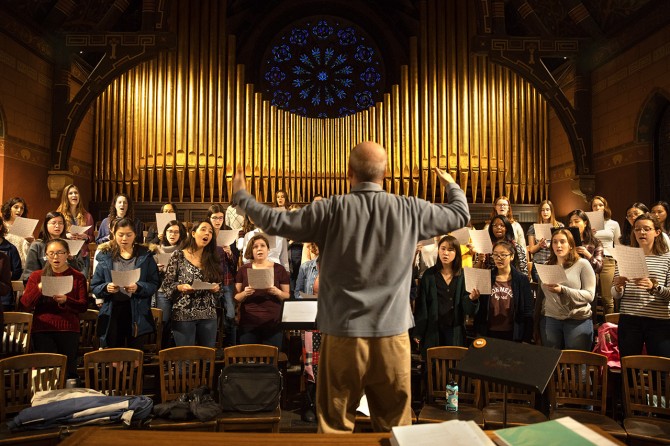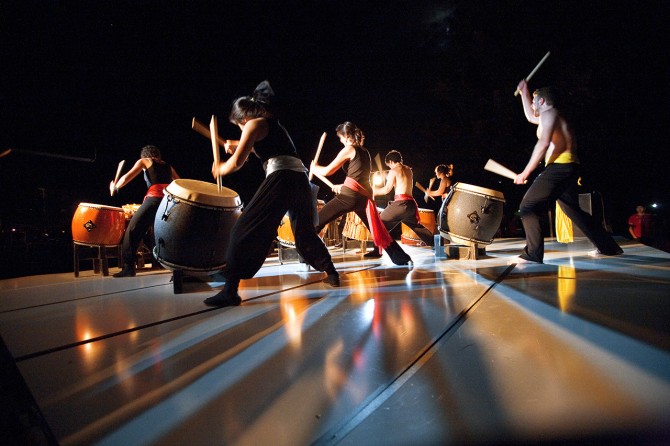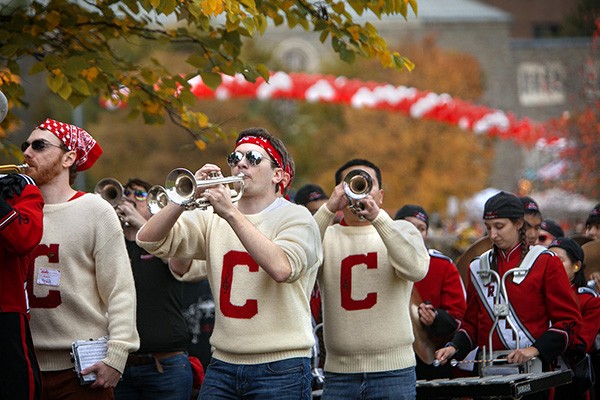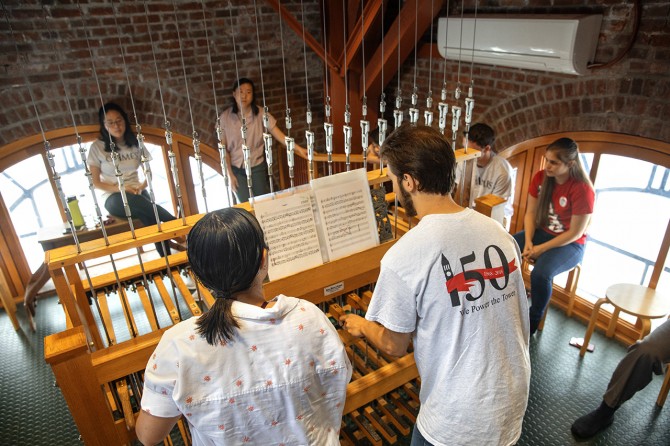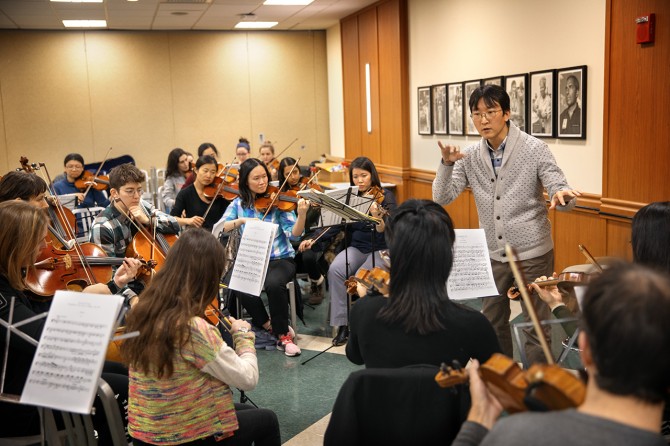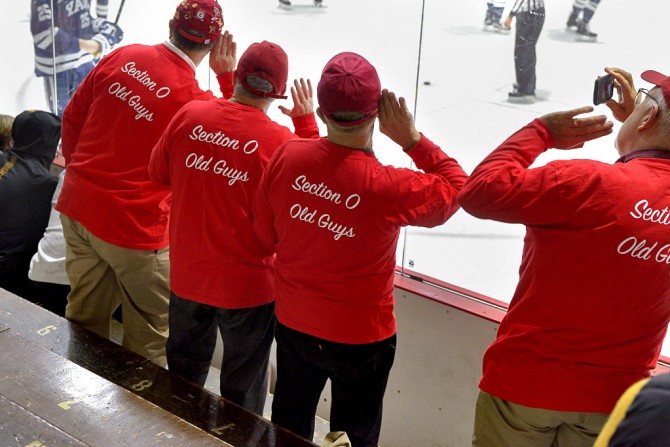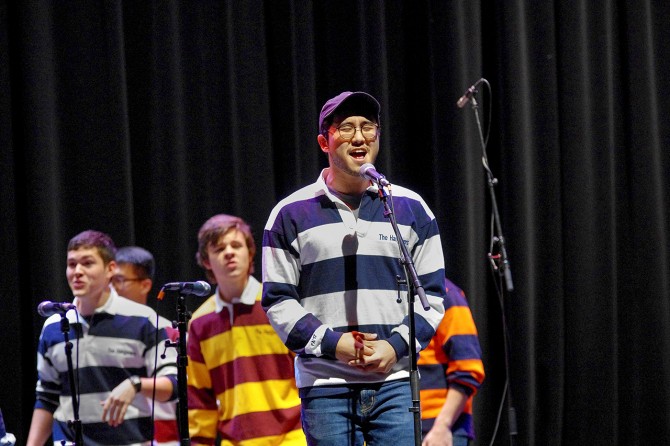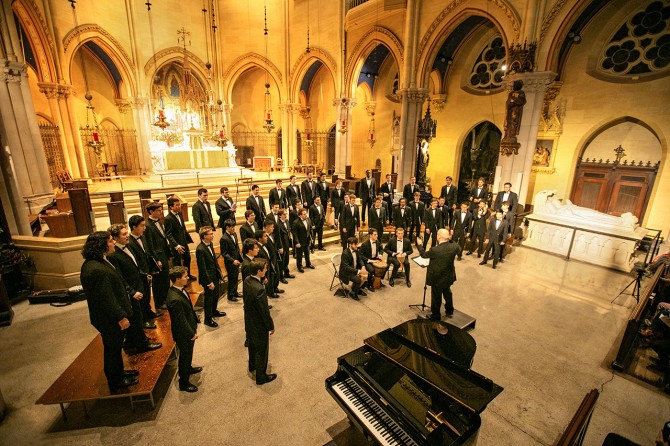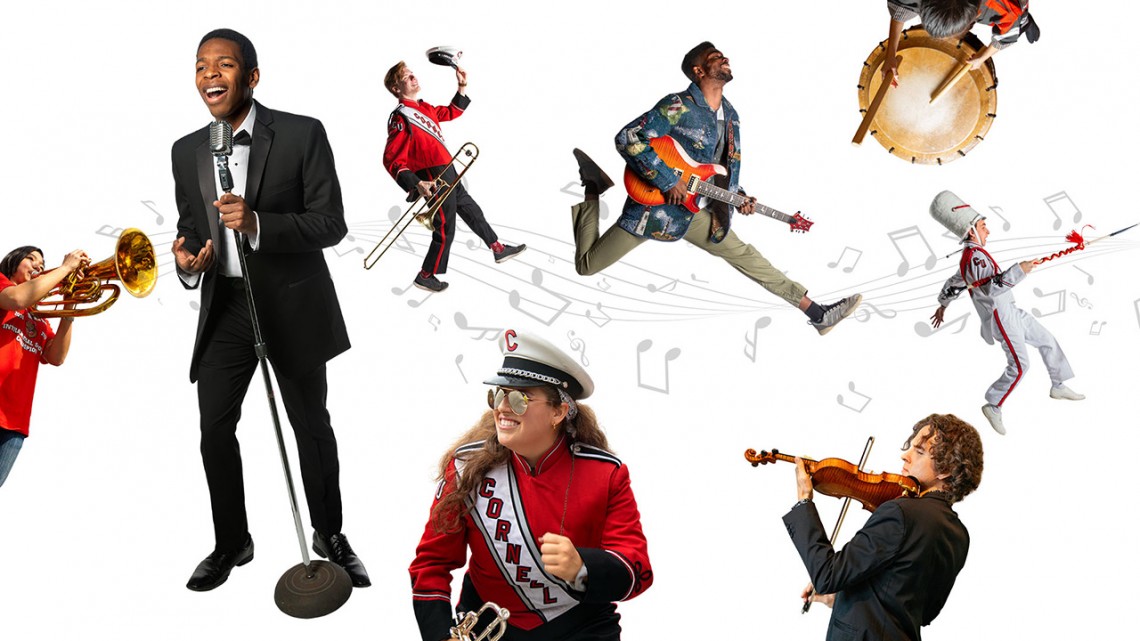
Cornell students, alumni and guest performers on campus celebrate music.
Musicians ♥ Cornell
By Kate Blackwood
Mary McDonald ’78 discovered her voice at Cornell.
Originally a French horn player, McDonald joined the Cornell University Chorus, the women’s vocal ensemble, during her sophomore year and won an audition for free voice lessons.
“I had never had formal voice lessons,” she says. “One day, I asked, ‘What about these notes up here?’”
Her voice teacher, hearing her amazing coloratura range, immediately gave her the famous “Queen of the Night” aria from Mozart’s “The Magic Flute,” and McDonald fell in love with opera, changing her life’s direction to pursue it. One of her most memorable Cornell moments came when she performed the soprano solos in Debussy’s “La Damoiselle élue” backed by the Cornell University Chorus and an orchestra.
“Having the support of the whole chorus behind me made me feel so supported and exposed at the same time – a total confidence-builder,” she says. “There is nothing like that experience of singing with like-minded people, creating this wall of gorgeous sound.”
After graduation, McDonald earned a master’s degree in vocal performance at Ithaca College and went on to a professional singing career.
Her friend Betsy Erickson ’80 also found her voice, albeit of a different sort, through Cornell musical activities. The first president of the Cornell University Chorus, Erickson advocated for and secured better resources for the chorus from the university administration and helped start alumni outreach efforts that sustain the group today.
“It was a very empowering experience for me because I was able, with the help of others, to change the trajectory of the chorus, to make things better,” she says.
Erickson and McDonald’s friendship began in rehearsals, performances and travels with the chorus, and it still includes a lot of music. They are not alone. Music shaped the student experiences of thousands of alumni who are a special population of Cornellians.
“There is something about making music together that quickly forms a lifelong bond in a way that few other human activities do,” says John Funkhouser ’89, who played piano and bass in Cornell University Jazz Ensembles. He now teaches at Berklee College of Music and performs regularly around Boston.
“The beauty of singing in a choir is that it’s not about an individual voice, but about 60 voices adding up to one glorious sound that is better than any individual member,” says Cornell University Glee Club alumnus Patrick Chamberlain ’13, director of artistic planning with the New Jersey Symphony Orchestra. “It also engenders an incredibly supportive and welcoming community.”
Members of this community give back, especially to help future generations, and carry this special love for each other and the university – like the words of a tune they know by heart – with them wherever they go.
‘My core Cornell family’
Cornell is a big place. Students find niches within the larger community, and musicians are no exception. In fact, by the nature of their art, musicians are models of teamwork and community.
“Cornell’s orchestra and wind ensemble program quickly forms a family for new students on campus,” says Derek Maseloff ’17, a French horn player who joined the Cornell Symphony Orchestra his first year. “Orchestra is fantastic for finding similarly minded people on campus.”
Cornell offers many musical opportunities. For-credit vocal and instrumental ensembles in the Department of Music in the College of Arts and Sciences include orchestras, wind ensembles, jazz ensembles and world music groups such as gamelan and Brazilian samba.
The Glee Club and Chorus offer course credit and are recognized as independent clubs with long traditions of student leadership and financial self-sufficiency. The Big Red Bands is another hybrid, housed within the Department of Athletics and Physical Education but run by students and advised by alumni.
Performance groups in many styles of music – including gospel, Middle Eastern and ukulele ensembles – find homes as student organizations. Fourteen a cappella groups are now organized under the A Cappella Advisory Council. Students interested in music don’t have to look far to find friends.
Eva Kestner ’09 created a family for herself and others when she and Haruki Yukawa ’09 founded Yamatai, the Japanese taiko drum ensemble.
“It was my first time living far away from home – Tokyo – and I felt that being a part of this group would allow me to express my identity and express myself musically,” she says. “My teammates have become lifelong friends.”
Crystal Cun ’07 says her best stories from Cornell involve the chimes and Big Red Marching Band. She was recruited her first week on campus to play glockenspiel in the marching band, even though all she’d ever played was piano. She tried out the next year to be a chimesmaster – one of a select group of students who play the chimes three times a day in McGraw Tower.
“It was wonderful to be part of two musical organizations which are so central to Cornell’s history and school spirit,” says Cun, who now lives in Brooklyn. “I always got a kick when the groups overlapped, such as when the marching band’s tuba players came into the belfry to play at Halloween.”
Traditional pranks, shows and tours make for vivid memories for many alumni, while the daily rigor of being part of an ensemble shaped their schedules on the Hill and relationships that often last far beyond graduation.
Everett McElveen ’92, who sang in the Glee Club and the Hangovers, says four weekly rehearsals plus frequent travel formed tight friendships: “That happens when you’re traveling around, singing places, having to ride in a van for hours. You get to know each other well.”
Instead of hindering his academic work, the full music schedule actually helped. “You knew you had to be at rehearsal. You knew you had this gig to go to. You knew what was on your calendar, so you got into a routine,” says McElveen, CEO of Community Human Services in Pittsburgh. He has stayed active in church ensembles and an African drumming ensemble.
“The Big Red Bands were, and still are, my core ‘Cornell family,’” says Neil Anthony Lewis Jr. ’13, a tuba/sousaphone player who was Pep Band conductor and manager. “We not only practiced and performed together, we also studied together, hung out together, traveled across the country together. We were always there for each other.”
Now an assistant professor of communication in the College of Agriculture and Life Sciences, Lewis no longer makes music, but says, “Big Red Band people are still some of my closest friends.”
A lasting musical community
Music sustains Cornell friendships among alumni long after Commencement. Some live together after graduation; Jacob Cohen ’16 shares living space with Glee Club and Chorus friends in Washington, D.C. Some musical alumni form actual families. Marching band tuba player Brian Adelman ’09 married a fellow “bandie,” Shayna Gerson ’10, and they are introducing their daughter to Cornell music in their Chicago home.
“We sing the ‘Evening Song’ in our house,” he says. “It’s a great lullaby.”
Cornell music can become a family legacy. Lane McClelland ’70, M.B.A ’73, J.D. ’74, tried out to be a chimesmaster because her mother, Phyllis Dittman ’43, was one.
Many musical alumni make music together, formally and informally. New York City is a particular hotbed of Cornell alumni and music groups, and Weill Cornell Medicine’s Music and Medicine Initiative has been nurturing medical students’ musical lives for the past 10 years.
“I’ve bumped into a couple of alums in volunteer community orchestras here in NYC,” says Derek Hsaing ’04, a real estate developer who plays violin with the Park Avenue Chamber Symphony on the side for fun. “I’m always looking for cellos!”
Others settle far from Cornell friends but bring music with them. “When I moved overseas, I took my violin as a carry-on,” said Laura Whitehurst ’07, an engineer in New Zealand. “One of the first things I did was find an orchestra to join. It’s amazing how much music can open doors.”
Coming back to join in
The double bond of lasting friendships and musical participation brings Cornell musical alumni back to campus often and enthusiastically.
At Homecoming each fall, band alumni bring or borrow instruments, wear their red-and-white letter sweaters and fall into step with current band members.
More than 40 chimesmasters gathered for Homecoming 2018 last September to celebrate the sesquicentennial of the chimes. Coming back to play has special meaning for this group because their instrument exists only at Cornell; “open chiming sessions” can go on for hours.
“No other instrument in the world has the same 21 bells as Cornell,” says chimesmaster Scott Silverstein ’08.
Similarly, pep band alumni need to be back on campus to truly do what they do best – boost Big Red spirit. Four alumni, all Class of 1981, come back annually for hockey games in Lynah Rink.
“We generally sit in Section O, across from the Pep Band and student sections, from which we lead cheers and encourage the band in song selection,” says David Dilzell, speaking also for Dan Metsa, Mark George and Gary Thompson.
The Section O Old Guys, as they are known, also come back for Reunions and Homecoming, occasionally joining in: Dilzell on saxophone, Metsa on percussion, George on trombone and Thompson on trumpet.
The Glee Club, at its traditional Homecoming concert, invites its alumni onstage to sing Cornell songs and “Ave Maria” by Franz Biebl, which every Glee Club alumnus knows by heart.
Reunion concerts involve choral music alumni at an even higher level; they learn difficult pieces of music ahead of time and then perform them after rehearsing twice.
During Reunion 2019, June 6-10, the Glee Club will celebrate its 150th anniversary. “We have a major celebration planned with the hopes of enticing as many alumni as possible to return to the Hill for singing and celebration,” says Chamberlain. Alumni have been planning the sesquicentennial for at least 10 years.
Musical alumni also come back often just to listen, supporting current ensembles. The Key Elements, an a cappella group, routinely welcomes alumni back to its concerts. “We pride ourselves on the closeness of our alumni base,” says
Sesha Kammula ’19, the group’s recording manager.
“One of the joys of being an alum is sitting in the audience,” says Glee Club and Hangovers alumnus Terry Horner ’92, Ph.D. ’98.
Giving back to support the future
Musical alumni do more to support current students, however, than just sit in the audience. Many are volunteer leaders for Cornell in both musical and nonmusical endeavors. Horner, for one, is president of the Cornell Club of Washington, D.C., and a class officer in addition to his Glee Club connections.
Alumni involvement is vital to several Cornell musical organizations. The Big Red Bands relies on a board of alumni volunteers for guidance, financial organization and continuity. Similarly, the Chimes Advisory Council plans events and established an endowment fund for the Cornell Chimes program.
The Chorus and Glee Club both have alumni advisory councils; student leaders plan performances, raise money and make travel arrangements, while alumni give long-term support.
Rebecca Sopchak Coatney ’08, a Chorus advisory council member since 2013, chairs the campaign for the Chorus’ endowment fund. The goal is to have $1 million in the endowment by the ensemble’s centennial in the 2020-21 academic year. It’s a huge undertaking, Coatney says, nearly quadrupling the endowment, but she is optimistic. Over 100 years, the alumnae base has grown both in numbers and in capacity to support future generations of Chorus members.
Building on common bonds and community spirit, musical alumni support ensembles financially with gifts of all sizes. Robert Cowie ’91, alumnus of the Jazz Ensembles and a pianist in New York, gives annually to the Cornell Jazz Ensembles Alumni Endowment. He also shares his expertise, coming back to talk to students in the music program about life as a musician after Cornell.
“I try to donate every year,” says New Zealand engineer Whitehurst. “I usually donate to the [orchestra] tour because I remember how profound an experience that was for me when I was a student.”
In addition to annual giving, major gifts from alumni have transformed Cornell’s music programs. For example, Priscilla “Percy” Browning ’56 named the director position for choral programs, now held by Robert Isaacs. And Barbara and Dick Silver ’50, M.D. ’53, recently funded a new music professorship and are supporting the wind symphony.
Big Red Bands alumni Sarah Fischell ’78 and her husband, David Fischell ’75, M.S. ’78, Ph.D. ’80, were lead donors for the Fischell Band Center, which became the new home for the bands in 2013.
The Section O Old Guys contributed significantly to the Fischell Band Center, and the office in that building is named for one of them, Gary Thompson ’81, who has also sponsored marching band and pep band trips to Washington, D.C., and Virginia.
The Big Red Bands are almost entirely self-supporting through student fees and alumni contributions, Dilzell points out: “Beginning with band camp before freshman year, through innumerable hours dedicated to the groups as students, and by participation as alumni, the bonds among members of the Big Red Bands are incredibly strong.”
‘You carry your instrument with you’
Those bonds allow all alumni musicians to take the university with them in the form of memories, friendships and tunes. Ithaca resident Adam Perl ’67 was singing during a 1991 reunion with about 30 of his fellow Glee Club alumni when he heard this for himself.
“We realized we could sing any of the Cornell songs without music, without instruments,” he says. “If you get even four guys together who can sing, you can make that music. You carry your instrument with you wherever you go.”
Perl and this particular group of alumni had carried their voices a long way before they even graduated from Cornell. As members of the Glee Club, they took the spring 1966 semester off from studies to give concerts across Asia on behalf of the U.S. State Department. They came back changed in ways that continue to this day.
The empowering experiences Erickson had at Cornell give her a sense of loyalty and connection today. She sometimes carries a tote bag printed with the Cornell University Chorus logo. One day recently, a woman on the street saw the bag and said, “Oh, did you go to Cornell?”
“We had this instant connection even though she wasn’t a singer,” says Erickson. “She recognized Cornell and wanted to chat with me about Ithaca. I feel that is a strong connection.”
The Chorus tote bag happened to be the opening note of a conversation, the first phrase of a set of good memories of experiences that are still in her life.
Cornell’s musical alumni carry Cornell with them, wherever they are, through the lyrics, melodies and traditions integral to the university’s history and character. And, as do so many alumni, they carry Cornell symbolically, a reminder that the university itself – and its influence on the world – is about many voices adding up to something greater than any individual member.
Media Contact
Get Cornell news delivered right to your inbox.
Subscribe
